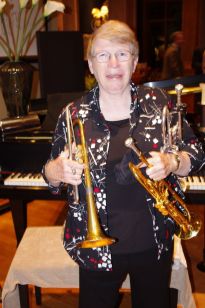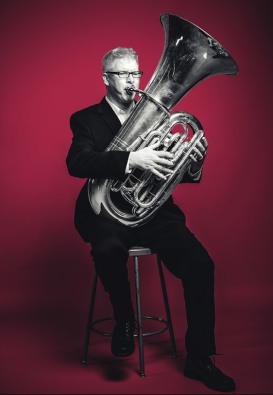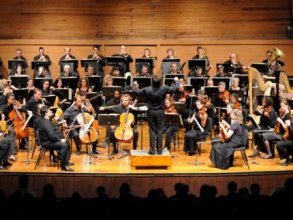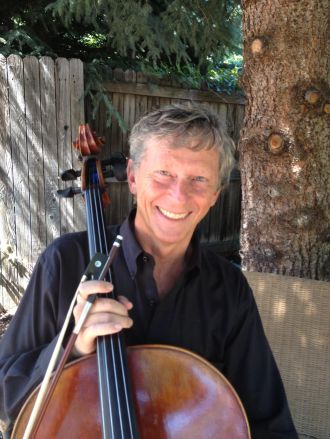“Blind” orchestral auditions have leveled the playing field.
By Peter Alexander

Missy Mazzoli was composer in residence with the Boulder Philharmonic in 2016
Sometimes a cliché is true.
For example, for women entering the field of classical music, there’s some good news and some bad news. Depending on the career goals, the prospects can be good, mixed, or troubled.
In a year when women’s status in society is daily in the news, this is a timely subject. For the purposes of this article, I will look at the orchestral scene, the most visible part of the classical music world and one where numbers are easily available.
First the good news: professional orchestras are filled with women today, a vast contrast to 40 or 50 years ago when orchestras were almost entirely male. This is now a viable career for the most talented women instrumentalists.
The bad news is that the picture is not nearly as rosy for women composers, who are not well represented on orchestral programs. And women conductors are no better off than composers.
The growing numbers of women in professional orchestras at every level can be traced to a single innovation that began around 1970: “blind auditions,” where competing candidates for open orchestral jobs play behind a screen. The selection committee does not know if it is hearing a man or a woman. The rapid change in the makeup of orchestras since 1970—casually visible and backed up by the numbers—is compelling evidence of the opposition women orchestral players faced before that innovation.

Susan Slaughter
Susan Slaughter, the first female principal trumpet player in the U.S. was interviewed in 2009 when she retired after 40 years in the St. Louis Symphony. In the article in the St. Louis Post Dispatch, she recalled that orchestras were not interested—until they heard her play. She wrote to 30 orchestras when she was starting out, and was invited to three auditions.
When she auditioned for St. Louis, one string player on the committee later admitted that he actually got up to go get coffee when she walked onstage. “He waited to hear a few notes, just for form’s sake,” the article said. “He said, ‘Your playing made me sit back down.’”

Elizabeth Baker
Violinist Elizabeth Baker, a member of the Los Angeles Philharmonic since 1987, has experienced auditions from both sides of the screen. She does not doubt the importance of blind auditions. “The screened rounds were the main reason why women were able to advance and realize positions in major symphony orchestras,” she says.
She has seen this in her own family. Her mother, Virginia Voigtlander Baker, was one of the first women in a principal string position in an American orchestra. She was engaged as assistant concertmaster of the San Francisco Symphony in 1972, shortly after the introduction of screened auditions, and held the position until 1993.
Baker’s belief is supported by scientific research. In an article titled “Orchestrating Impartiality,” published in 2000 in The American Economic Review, researchers Claudia Goldin and Cecilia Rouse concluded that “the screen increases—by 50 percent—the probability that a woman will be advanced from certain preliminary rounds and increases by severalfold the likelihood that a woman will be selected in the final round.” Their conclusion is backed up by 25 pages of charts, graphs and statistical studies.

A violinist prepares to play an audition behind the screen.
The numbers are striking. According to the most recent information from the League of American Orchestras, the percentage of women instrumentalists has gone from 38.2% in 1978, the earliest year that these records were kept and already after the first screened auditions, to nearly 50% today. Some individual orchestras have up to 60% women.
The numbers are similar locally. Based on the rosters on their Web pages, approximately 44% of the Colorado Symphony and 58% of the Boulder Philharmonic is female. Significantly, the concertmaster of the Colorado Symphony is a woman, as are the assistant concertmaster and several principal players in the wind sections of the Boulder Phil.
The numbers were much lower before screened auditions were introduced. In the 1950s and ‘60s, orchestras were considered a male preserve. Older women instrumentalists often recall being explicitly told to get a college degree so they could teach, because “orchestra jobs are for men.”
Today blind auditions are just about universal in American orchestras. The Code of Ethical Audition Practices that professional orchestras follow does not specify screened auditions, although it does prohibit discrimination of the basis of sex, and they often are required in union contracts between orchestras and musicians.
# # # # #
Individual women composers have seen some well publicized successes recently. In December the Metropolitan Opera produced L’Amour de Loin by Finnish composer Kaija Saariaho to great acclaim—the first opera by a woman at the Met in 113 years. The Santa Fe Opera premiered Jennifer Higdon’s Cold Mountain in 2015, and Opera Colorado premiered Lori Laitman’s Scarlet Letter in 2016. But while such widely publicized events may open doors for other women, they do not tell the whole story.

Jennifer Higdon’s “Cold Mountain” was premiered at the Santa Fe Opera in 2015
For one thing, composers do not have the advantage of auditioning anonymously. Music directors and board committees know whose music they are choosing. “We’re completely at the mercy of the people who do the programming,” Higdon explains. “We have no control over our careers, basically, especially in the orchestral realm.”
A highly successful composer by any standard, Higdon is an exception, a Pulitzer prize winner with more than 200 performances every year. But that does not mean she has not met casual sexism in her career. People still tell her “I can’t believe a woman wrote that piece!” and she was even asked by a documentary filmmaker once if he could get a shot of her ironing.
“I was like, ‘What? Did I hear that correctly?’” she recalls.
Missy Mazzoli, a 2016 composer in residence with the Boulder Philharmonic, points out that women composers often cannot know when discrimination occurs. “It operates on different levels, a lot of which I would be the last person to be aware of,” she says. “I’m not behind closed doors where people are making decisions, but I think the numbers speak for themselves.”
What the numbers say depends on which ones do the speaking. In the 18th, 19th and early 20th centuries, the period that still forms the largest part of the classical repertoire, women were discouraged, when not actually prevented, from being composers. That is no longer the case, so while there is little music by women from the core of the classical repertoire, there is a great deal of newer music by women.
Statistics kept by the Baltimore Symphony reflect that discrepancy. They show that only 1.8% of all works performed by major orchestras in 2014–15 were by women. But when limited to works performed by living composers, that number jumped to 14.8%.

Boulder native Kristin Kuster
Still, that remains a smaller share of the repertoire than the growing numbers of women composers would suggest. Kristin Kuster, a composer from Boulder who teaches at the University of Michigan, reacted when the figures were first released, writing, “These numbers are both abysmal and embarrassing, particularly in this day and age.”
She knows first-hand how many women are moving into composition. “We are seeing a gradual increase in the number of female composers applying to our undergraduate and graduate programs” at Michigan, she says today. And at last summer’s “Composing in the Wilderness” workshop in Alaska (covered in Boulder Weekly in October), open registration attracted five women and four men.
Local figures hover around the national averages. In the 11 seasons under conductor Michael Butterman (including the current season), the Boulder Philharmonic has played six pieces by six different female composers. That is approximately 3.2% of all the repertoire programmed on major concert performances, slightly above the 2014–15 single-season national average . Among living composers, it is 15%, almost exactly the national average.
That is a stark difference from the orchestra’s early years. In all of the recorded repertoire before Butterman, back to 1966, the percentage of women composers on concert programs was exactly 0—unless you count the 1995 “performance” of “Happy Birthday” by Mildred and Patty Hall.
For the Colorado Music Festival, it is more difficult to calculate percentages, because there are so many different genres and ways of listing programs. What can be gleaned from the records is that in the first 20 years of the festival, through 1996, there were seven works played by women—six of them by Betsy Jolas, who is also part of the upcoming 40th anniversary season.
More recently, Michael Christie’s 13 years with the festival featured nine works by seven women. Looking only at Festival Orchestra concerts that have full program listings in the record, three women make up 1.3% of all composers and 9.4% of living composers in the Christie era, below the national averages. For the CMF Chamber Orchestra in the same period, however, the figures are slightly above the national average: five women represent 2.5% and 17.9% respectively.

“Click” Commission winner Hannah Lash
Since Christie left, the only works by women were Hannah Lash’s “Click” Commission winner in 2016, and the upcoming piece by Jolas.
The “Click” Commission choice is particularly interesting. The commission has been granted in five festival seasons between 2011 and ’17. The winners of the commission are selected by the public, who vote with their pocketbooks by making contributions.
In those five years, there have been 14 men and three women candidates. Of these, the voters selected three men and two women—Kuster in 2013 and Lash in 2016. This is a far higher rate than women have been programmed locally or nationally. Since there were two women candidates in 2013, voters have actually chosen a female composer every time one was available. This is a very small sample, but it suggests that, at least in Boulder, audiences are more willing than program committees and music directors to choose female composers.
This adds up to a mixed picture for female composers: progress, but well short of representation in proportion to the numbers of active composers. For her part, Kuster calls on everyone to be part of the solution. “We all have a responsibility to change our culture to be more inclusive, and to represent the reality that there is a vast diversity of musical voices to be heard,” she says.
# # # # #
The most prominent musicians at orchestral concerts are the soloists and conductors. For soloists, the rise of women in orchestral positions has been paralleled by women with solo careers, particularly violinists. The rosters of three of the largest artists management companies in New York—Columbia Artists, IMG and Opus 3—together list 37 violinists, of which 16, or 43.2%, are women. Female pianists fare less well, with 13 out of 59, or 22%.
But it is as conductors that women appear least successful. In this area, management rosters may slightly underrepresent women. The management companies represent 153 conductors and only 11 women, or 7.2% of the total, whereas the numbers of women in actual orchestral conducting positions are slightly higher.
The League of American Orchestras reports that among all conductors at league orchestras—including both music directors and assistants—14.6% are women, almost exactly the same rate at which women are included in orchestral programs. At the highest level, 9.2% of all music directors of LAO orchestras are women. However, the discouraging fact is that both numbers have changed very little over the past 10 years of league records, and throughout the same period there has been only one female music director in the top 24 U.S. orchestras by budget, Marin Alsop at the Baltimore Symphony.
Whatever numbers you look at, women are underrepresented at the top levels of the orchestral world. When asked about this, women refer over and over again to the same issues that face women in leadership positions in business and other fields: it is more difficult for women to be taken seriously as strong leaders.

JoAnn Falletta
JoAnn Falletta, music director of the Buffalo Symphony and one of the senior women conductors today, explains it this way: “Probably the greatest factor is that [symphony] boards are run by people who believe very strongly in the status quo. And that means board members trusted generally in an older man, and I think that has lasted for decades.”
Beverly Everett, music director in Bismarck, N.D., and Bemidji, Minn., is well accepted in both communities, but says that in many cases boards’ “perception of leadership is someone who can go out and be buddy-buddy with someone on a golf course.” One position that she considered, she recalls, “I had a friend who knew some of the people on the board, and they told him flat out that they would not consider a woman.”
Laura Jackson, music director of the Reno Philharmonic, says the perception of a conductor is often even more narrow than that, of an older European male—a long-term prejudice in the U.S. that can hamper younger men as well as women. “The average person has in their mind a Toscanini, sort of an Einstein-looking character,” she says. “The young male conductors suffer from the stereotype as much as I do.”

Laura Jackson
The good news is that it is not usually the musicians in the orchestra who have a problem with women conductors. “Most people just want somebody competent on the podium, period,” Jackson says. “If you’re an iguana and you do what you do well, they’ll take it.”
She has seen more concern about the gender of the conductor from the public than from musicians. When she was a conducting fellow at Tanglewood, Mass., she says, “It was the patrons who said, ‘Do you realize how long it’s been since we had a female here? This is really freaky!’”
That perception in turn puts extra pressure on women conductors, who may be seen as representing all women. “It was scary because I felt like one false move, if anything was wrong, it would end up being blamed on my gender,” Jackson says.
Another challenge that is familiar to all women in all fields is the difficulty of being assertive—which goes against society’s expectations of girls and women. For example, Falletta had to learn at the outset not to be apologetic. “There can be a subtle sense of apology in what women say,” she says.
Jorge Mester, a conductor who was Falletta’s teacher and mentor when she was younger, puts it more bluntly. “It’s the teaching that little girls are given about being subservient,” he explains. “I said to her, ‘JoAnn, do you want to be a nice Catholic girl, or do you want to be a conductor?’”
In other words, women have to step outside the traditional social role to exert leadership—but if they are too assertive they run the risk of being perceived as shrill, or worse. “The most difficult thing is figuring out the window of leadership where you can be commanding and make a point passionately without being seen as angry, where you can be not seen as brittle and mean,” Jackson says.
Another challenge familiar to women in business is dress. “For any performer male or female, the way you look is very important,” Jackson says. “With a woman there are many extra layers to getting that right. If a man walks in and his shirt is a little wrinkled, he’s a disheveled genius. If a woman looks like that, she’s incompetent.”
“Concert dress is something men may not even think about,” Falletta adds. “With a woman, it seems to be more laden with social importance.”
Women like Falletta and Jackson and Everett have shown that women can be successful orchestral conductors. But is that career path one that is becoming more open to women generally? The evidence is mixed. As noted, the numbers recorded by the League of American Orchestras have been static for at least ten years. And individual experience varies widely.

Cynthia Katsarelis
Cynthia Katsarelis, conductor of the Colorado Pro Musica Chamber Orchestra, is the only female orchestral conductor in the front range area. “When I was at the Peabody Conservatory, the conducting class was 50-50, male-female, all talented,” she observes. “At each new level of my career, there were fewer women. In top masterclasses and summer programs there would be fewer women. I would be the only woman at several professional auditions and now there are many music director searches where no women are auditioned.”
As it happens, that has been exactly the case in the most recent high-profile searches in this area.
In 2010, the Colorado Symphony had eight guest conductors, all European males, and hired Andrew Litton from that field. Six years later, Brett Mitchell was hired to replace Litton, without any other candidates appearing with the orchestra. Around the same time, two other men were hired in conducting positions, Associate Conductor Christopher Dragan and Assistant Conductor Andres Lopera.
In 2014, the Colorado Music Festival featured four official candidates to replace Michael Christie, all male. The two or three other names that were informally discussed were also male. The Longmont Symphony is currently searching for a new conductor, and once again all the finalists are male.
That’s the local picture, but it may not be broadly representative. Jackson believes more women are coming into the field. “In the past three years it’s like the floodgates are opening,” she says. “I think we are on the cusp. I think that I have probably done my last music director audition where I am the only woman.”
She sees some situations where being a woman may even be an advantage. “For an orchestra that needs a big change, when they see your résumé and see your picture, you are automatically that change, that clean slate,” she says. “That can put you in a category where people will ask, ‘Why not?’
“I think it’s going to be less and less of an issue.”
Falletta believes that the publicity around some recent high-profile women conductors helps. The Finnish conductor

Susanna Malkki conducted at the Metropolitan Opera in 2016
Susanna Malkki, chief conductor of the Helsinki Philharmonic who also who led Saariaho’s L’Amour de Loin at the Metropolitan Opera is one example. Another is Mirga Grazinyte-Tyla, new music director of the City of Birmingham Symphony in England. In 2013, Alsop became the first woman to conduct the BBC’s “Last Night of the Proms” in London.
“Once it’s happened on a high level, people are more open to it,” Falletta says. “All of us tend to look to orchestras that are bigger than us as models. As they start to have more women on the podium—and more women composers, as well—I think smaller orchestras will do the same.”
At least the way is now open for women to learn the skills as conductors. University and conservatory programs are accepting women, and the Dallas Opera has made a 20-year commitment to its Linda and Mitch Hart Institute for Women Conductors. The League of American Orchestras has held special programs for women conductors, as did the Lucerne Festival in 2016.
In the end, it all comes down to fairness, and the opportunity of talented women to pursue the career of their choice. But Higdon has her own perspective on the whole issue, that opening doors to women is good for classical music generally.
“Young people don’t come to classical concerts because it looks so un-hip,” she says. “One reason is because there are so few women represented. They are used to women being part of the scene from popular music and hip-hop and everything else they listen to.
“If you want to be more hip and appeal to younger audiences, program more women!”
NOTE: An abridged version of this story appeared in Boulder Weekly.
Edited lightly to correct typos and clarify the numbers that are provided, 4/13.





































